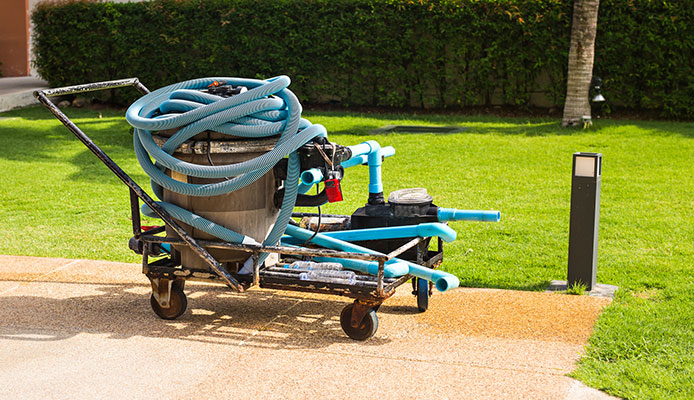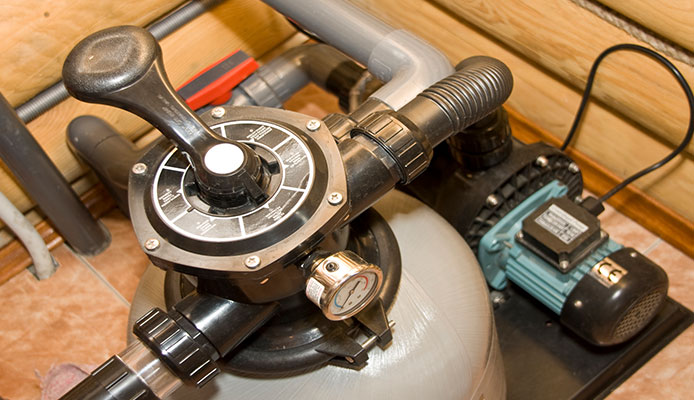
The best pool pump will help keep your water running in the pool while also making sure that it won’t be a breeding ground for bacteria. To maximize its benefits, it is crucial to choose a pump with the right size for your pool. When the pump is under or over-powered, the performance is compromised, and you won’t be able to yield the full benefits of its use.
If you are clueless about what size pump do I need for my above ground pool, read on and we got you covered. As a bonus, you will also learn about what size sand filter for above ground pool is the best.
What Size Pump Do I Need for my Above Ground Pool?
Choosing a pool pump is not as easy as picking the cheapest product available in the market. If it was that simple, then no one would bother making calculations or getting technical. Similar to choosing pool heaters, you need to make sure that you pick one that is suitable for the size of your above ground pool.
To make things easier, here’s a step-by-step guide to find the right above ground pool pump for your needs.
-
Determine the Volume of the Pool
The first thing that you need to do is to determine how many gallons of water are in the pool. The size of your pool, depth, and shape, among others, will have an impact on this. There is an online calculator that will let you easily compute the volume. Find one so that you don’t need to rely on guesswork.
In our example calculation, let us say that the above ground pool has a volume of 24,000 gallons.
-
Determine the Gallons per Hour
Now that you know the volume of your above ground pool, the next value that you will need to determine is the gallons per hour or GPH. This dictates the volume of water that is pumped through the filter in an hour.
Going back to our example, if the volume is 24,000 gallons and you divide it by 8, then you will get 3,000.
However, most pumps will be labeled based on gallons per minute or GPM instead of GPH. If that’s the case, then you have to divide the GPH by 60. In our example, it will be 3,000 divided by 60. From here, you will be able to determine that the appropriate water flow rate is 50 GPM.
Based on the calculations earlier, you are probably wondering why we used 8 in dividing the volume of the pool. This refers to the turnover time, which is described as “the amount of time it takes to move a volume of water, equal to the size of your pool, through the filtration and sanitation process once.” The range can also be ten hours, and if that is the case, then you have to divide 24,000 by 10 instead of 8.
-
Find the Right Pool Pump
Now that you are done with the calculations, it is time to start looking for the right pool pump to optimize your above ground pool. Refer to the technical specifications from the manufacturer to find one that matches your needs.
Based on the computation above, check the table below for a quick summary of the right pool pump sizes based on the most common pool sizes.
| Pool Size | Turnover | Minimum Flow Rate |
| 35,00 US Gallons | 8 hours | 73 GPM |
| 35,000 US Gallons | 10 hours | 58 GPM |
| 24,000 US Gallons | 8 hours | 50 GPM |
| 24,000 US Gallons | 10 hours | 40 GPM |
| 18,000 US Gallons | 8 hours | 38 GPM |
| 18,000 US Gallons | 10 hours | 30 GPM |
-
Calculate Feet of Head
If you are curious about what size pump do I need for my above ground pool, you can stop with the computation above. However, if you want to be more technical, then there’s another thing that requires your attention – feet of head.
The total resistance to flow is the feet of head. This refers to the average length that it takes the skimmer to reach the above ground pool pump. This is the number if you have a single skimmer. If you have multiple pool skimmers, on the other hand, you need to find the average. However, as you can see above, we were able to calculate the pump size without dealing with feet for head, so we won’t talk about its formula to keep things simple.
The Importance of Proper Pool Pump Sizing
What size pump do I need for my above ground pool? This is another question most pool owners have. It may be easy to pick just the one with the highest GPM or GPH, but that should never be the case.
Like with lower or increase pH levels in pools.
On the other hand, when you choose a pump that is too big for your pool, this will result in unnecessarily wasting energy. This can also negatively impact the pool filter’s performance and increase wear.
What Size Sand Filter Do I Need for my Above Ground Pool?
After figuring out the right pump size, the next thing that you should do is to think about the right sand filter size. With the right pool filter, you can be more confident about cleanliness and safety.
A lot of sand filters are undersized because pool owners opt for the cheapest option possible. This should not be the case. When it comes to sand filters, bigger is always better. As long as it is matched with the right pump, you will not have a problem when you choose a sand filter with a large capacity.
It is safe to go for a filter that is at least one size larger than what you think you will need. This will allow it to capture more debris, making it more efficient. This is also a good thing because it means that it will require a longer time before cleaning or replacement of the filter.
Finding the right size of the sand filter is similar to finding the right size of the pump. First, you determine the volume and the capacity of the pool. Once you have the values, divide it by eight or ten depending on the turn-over. Then, you will divide it by 60 to get the gallons per minute, and this number will be your basis as you look for the right sand filter that matches your needs.
The size of the sand filter is referred to its design flow rate, which is often expressed in gallons per minute. Check the Pump Flow Chart, which is included in the technical details that you can see in the manual.
While it will be good to have numbers to use as a basis, the formula may not always be the determining factor. For instance, you also have to consider how often you use the pool and the dirt that it gets. If you use it all the time and if it accumulates excessive dirt, then the most logical thing to do is to opt for a larger filter compared to what you have determined based on your computation.
The discussions above regarding sand filter sizing will hold true for any other filter that you choose. Even if you will use diatomaceous earth or cartridge filter, the same formula will be needed in calculating the right size.
Other Things to Consider
After talking about the fundamentals of the above ground pool pump and sand filter sizing, take note of the things that are listed below:
- Your pool pump’s GPM will be lower the farther it is away from the pool. The GPM will also be restricted depending on the construction of the pipes supplying water to the pool.
- If you have extra water features in your above ground swimming pool, such as fountains, spas, and waterfalls, you will need a pump with a higher flow rate.
- Make sure that the pool pump size is proportionate to the filter size. Most people prefer having a larger filter, which will minimize the work that the pump needs to do while making sure that the water is the above ground pool is moving. If you choose a pump with a higher flow rate compared to the filter, there is a possibility of providing unnecessary strain. In the end, this can result in a reduction of efficiency while also lessening their functional life.
- Do not be tempted to choose the highest GPM or HP. Most of the time, this can result in inefficiency. Take note that your pool’s pipe may not be able to handle an excessive flow rate. The movement and pressure of the water must match the size of your pump. So, take a look at the size of the intake line. For reference, if the pipe has a 1.5-inch intake line, then the recommended maximum flow rate is 42 GPM. On the other hand, with a 3-inch intake line, the recommended maximum flow rate is 160 GPM.
- Think of ways to go green. One of the best things that you can do is to go for a larger pipe when installing an above ground pool. This will improve the flow rate. Meaning, you will get more gallons per minute without increasing the horsepower of the pump. It supplies more water without consuming a lot of energy.
FAQs
Got questions about sizing pumps and sand filters for above ground pools? We’ll answer some of them before we conclude this article

Q: What size pump do I need for my pool?
For a 35,000-gallon above ground pool with a turnover of eight hours, you will need a pool pump with a minimum flow rate of 73 GPM. On the other hand, for a 24,000-gallon pool with a turnover rate of eight hours, the minimum flow rate is 50 GPM.
Q: How do you size an above ground pool pump?
To size an above ground pool pump, start by determining the volume of the water. Once you have the value, divide it by eight (the turnover rate), and you will get the gallons per hour. To convert it into gallons per minute, divide the value by 60.
Q: What size sand filter do I need for my above ground pool?
To determine the size of the sand filter that you need for your above ground pool, allocate 1 square foot for every 10,000 gallons of water. Meaning, if your above ground pool can accommodate 20,000 gallons of water, your sand filter should be 2 square feet.
Q: What size pump do I need for a 15,000-gallon pool?
On average, for a 15,000-gallon pool, you will need a pump with 20 GPM output if you intend to run the pool for 24 hours.
Q: How do I know what size pool filter I need?
To know the size of the pool filter that you need, you must determine the size or flow rate of the pump. This is often expressed as gallons per minute (GPM). At a minimum, the pool filter should be the same size as the pool pump. If you want to be safe, go for a larger filter compared to the pump.
Globo Surf Overview
At this point, we hope that you are no longer wondering about what size pump do I need for my above ground pool. As noted above, this depends on the pool’s volume and turnover rate in hours. This is the same formula for calculating the right size of the pool sand filter to use. Make sure that the sizes of the pump and the sand filter are matched to enjoy maximum effectiveness and efficiency.

